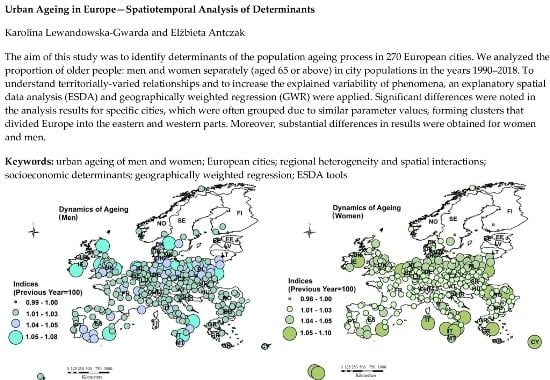Urban Ageing in Europe—Spatiotemporal Analysis of Determinants
Abstract
:1. Introduction
2. Data Analysis
2.1. Urban Population Ageing Data
- by gender: as a proportion of the female population on the 1st of January (65 years and over) in the total female population and the proportion of the male population on the 1st of January (65 years and over) in the total male population (both variables in %);
- by size of the city: below 100,000 inhabitants, between 100,000 and 250,000, between 250,000 and 500,000, between 500,000 and 1,000,000, and above 1,000,000 people [50];
- by the level of economic development: lower-middle income, upper-middle income, and high-income units [51].
2.2. Dynamics of Urban Ageing
2.3. Spatial Concentration of Ageing Process
2.4. Potential Determinants of European Urban Ageing
3. Methodology
4. Results and Discussion
5. Conclusions
Author Contributions
Funding
Conflicts of Interest
References
- Jones, S.E. Ageing and the City: Making Urban Spaces Work for Older People; HelpAge International: London, UK, 2016; Available online: http://www.nwtseniorssociety.ca/wp-content/uploads/2013/11/Ageing-and-City-Low-Res.pdf (accessed on 2 February 2020).
- World Health Organization. Available online: https://www.who.int/healthinfo/survey/ageingdefnolder/en/ (accessed on 2 February 2020).
- World Health Organization. Global Age-Friendly Cities: A Guide. Available online: https://www.who.int/ageing/publications/Global_age_friendly_cities_Guide_English.pdf (accessed on 2 February 2020).
- OECD. Available online: https://stats.oecd.org/viewhtml.aspx?datasetcode=CITIES&lang=en# (accessed on 2 February 2020).
- Monnier, A. Baby boomers: Towards the end of an era. Popul. Soc. 2007, 431, 1. [Google Scholar]
- Costa, D.L. Causes of improving health and longevity at older ages: A review of the explanations. Genus 2005, 61. [Google Scholar] [CrossRef]
- World Health Organization. Global Health and Ageing. Available online: https://www.who.int/ageing/publications/global_health.pdf (accessed on 2 February 2020).
- ESHRE Capri Workshop Group. Europe the continent with the lowest fertility. Hum. Reprod. Update 2010, 16, 590–602. [Google Scholar] [CrossRef] [PubMed] [Green Version]
- United Nations. World Population Ageing 2017. Available online: https://www.un.org/en/development/desa/population/publications/pdf/ageing/WPA2017_Highlights.pdf (accessed on 1 February 2020).
- Geller, A.M.; Zenick, H. Ageing and the environment: A research framework. Environ. Health Perspect. 2005, 113, 1257–1262. [Google Scholar] [CrossRef] [PubMed] [Green Version]
- Rogers, A.; Raymer, J. Immigration and the Regional Demographics of the Elderly Population in the United States. J. Geront. 2001, 56, 44–55. [Google Scholar] [CrossRef] [PubMed] [Green Version]
- Evans, B.; Palacios, R. Who is Poorer? Poverty by Age in the Developing World; World Bank: Washington, DC, USA, 2015. [Google Scholar]
- Kashnitsky, I.; de Beer, J.; van Wissen, L. Decomposition of regional convergence in population ageing across Europe. Genus 2017, 73, 2. [Google Scholar] [CrossRef] [Green Version]
- Leeson, G.W. The Growth, Ageing and Urbanisation of our World. Popul. Ageing 2018, 11, 107–115. [Google Scholar] [CrossRef] [Green Version]
- Šídlo, Ľ.; Šprocha, B.; Klapková, M. Regional differences in population ageing in Europe viewed through prospective indicators. Erdkune 2019, 73, 225–240. [Google Scholar] [CrossRef]
- Yang, L.; Zhao, K.; Fan, Z. Exploring Determinants of Population Ageing in Northeast China: From a Socio-Economic Perspective. Int. J. Environ. Res. Public Health 2019, 16, 4265. [Google Scholar] [CrossRef] [Green Version]
- Foster, L. Active Ageing, Pensions and Retirement in the UK. J. Popul. Ageing 2018, 11, 117–132. [Google Scholar] [CrossRef] [Green Version]
- Regan, J.C.; Partridge, L. Gender and longevity: Why do men die earlier than women? Comparative and experimental evidence. Best Pract. Res. Clin. Endocrinol. Metab. 2013, 27, 467–479. [Google Scholar] [CrossRef] [PubMed]
- Windhager, S.; Mitteroecker, P.; Rupić, I.; Lauc, T.; Polašek, O.; Schaefer, K. Facial aging trajectories: A common shape pattern in male and female faces is disrupted after menopause. Am. J. Phys. Anthropol. 2019, 169, 678–688. [Google Scholar] [CrossRef] [PubMed] [Green Version]
- Plouffe, L.; Kalache, A. Towards global age-friendly cities: Determining urban features that promote active ageing. J. Urban Health 2010, 87, 733–739. [Google Scholar] [CrossRef] [PubMed] [Green Version]
- Buffel, T.; Phillipson, C.; Scharf, T. Ageing in urban environments: Developing ‘age-friendly’ cities. Crit. Soc. Policy 2012, 32, 597–617. [Google Scholar] [CrossRef] [Green Version]
- Steels, S. Key characteristics of age-friendly cities and communities: A review. Cities 2015, 47, 45–52. [Google Scholar] [CrossRef] [Green Version]
- Moulaert, T.; Garon, S. Age-Friendly Cities and Communities in International Comparison: Political Lessons, Scientific Avenues, and Democratic Issues; Springer: Cham, Switzerland, 2016. [Google Scholar]
- Van Hoof, J.; Kazak, J.K.; Perek-Białas, J.M.; Peek, S.T.M. The Challenges of Urban Ageing: Making Cities Age-Friendly in Europe. Int. J. Environ. Res. Public Health 2018, 15, 2473. [Google Scholar] [CrossRef] [PubMed] [Green Version]
- Burian, J.; Zimmermannová, J.; Macků, K. Demographic Development Planning in Cities. In Spationomy; Pászto, V., Jürgens, C., Tominc, P., Burian, J., Eds.; Springer: Cham, Switzerland, 2020. [Google Scholar]
- Verderber, S.; Fine, D.J. Healthcare Architecture in an Era of Radical Transformation; Yale University Press: New Haven, CT, USA, 2000. [Google Scholar]
- Feddersen, E.; Lüdtke, I. Living for the Elderly: A Design Manual; Birkhäuser: Basel, Switzerland, 2009. [Google Scholar]
- Farrelly, L. Designing for the Third Age: Architecture Redefined for a Generation of “Active Agers”; John Wiley & Sons: Hoboken, NJ, USA, 2014. [Google Scholar]
- Simpson, D. Young-Old: Urban Utopias of an Ageing Society; Lars Muller Publishers: Baden, Switzerland, 2015. [Google Scholar]
- Park, J.; Porteus, J. Age-Friendly Housing: Future Design for Older People; RIBA Publishing: London, UK, 2018. [Google Scholar]
- Bowering, T. Ageing, Mobility and the City: Objects, Infrastructures and Practices in Everyday Assemblages of Civic Spaces in East London. Popul. Ageing 2019, 12, 151–177. [Google Scholar] [CrossRef] [Green Version]
- OECD. Demographic Change in the Netherlands: Strategies for Resilient Labour Markets. Available online: https://www.oecd.org/cfe/leed/Demo_change_netherlands_highlights.pdf (accessed on 2 February 2020).
- Cox, E.; Hendersonand, G.; Bake, R. Silver Citiesrealising the Potential of Ourgrowing Older Population. Available online: https://www.ippr.org/files/publications/pdf/silver-cities_Dec2014.pdf (accessed on 2 February 2020).
- Laperche, B.; Boutillier, S.; Djellal, F.; Ingham, M.; Liu, Z.; Picard, F.; Reboud, S.; Tanguy, C.; Uzunidis, D. Innovating for elderly people: The development of geront’innovations in the French silver economy. Technol. Anal. Strateg. Manag. 2019, 31, 462–476. [Google Scholar] [CrossRef]
- Beard, J.R.; Petitot, C. Ageing and Urbanization: Can Cities be Designed to Foster Active Ageing? Public Health Rev. 2010, 32, 427–450. [Google Scholar] [CrossRef] [Green Version]
- Galčanová, L.; Sýkorová, D. Socio-spatial aspects of ageing in an urban context: An example from three Czech Republic cities. Ageing Soc. 2015, 35, 1200–1220. [Google Scholar] [CrossRef]
- Jackisch, J.; Zamaro, G.; Green, G.; Huber, M. Is a healthy city also an age-friendly city? Health Promot. Int. 2015, 30, 108–117. [Google Scholar] [CrossRef] [PubMed] [Green Version]
- Turok, I.; Mykhnenko, V. Resurgent European cities? Urban Res. Pract. 2008, 1, 54–77. [Google Scholar] [CrossRef]
- Swiaczny, F.; Graze, F.; Schloemer, C. Spatial Impacts of Demographic Change in Germany—Urban Population Processes Reconsidered. Z. Bevoelkerungswissenschaft 2008, 33, 181–206. [Google Scholar] [CrossRef]
- Atkins, T.M.; Tonts, M. Exploring Cities through a Population Ageing Matrix: A spatial and temporal analysis of older adult population trends in Perth, Australia. Aust. Geogr. 2016, 47, 65–87. [Google Scholar] [CrossRef]
- Zainol, R.; Pettit, J.C. Elderly and Community Health Care Facilities: A Spatial Analysis. Geography 2016, 5. [Google Scholar] [CrossRef]
- Han, J.H.; Kim, J.-H. Variations in Ageing in Home and Ageing in Neighbourhood. Aust. Geogr. 2017, 48, 255–272. [Google Scholar] [CrossRef]
- Sabater, A.; Elspeth, G.; Finney, N. The Spatialities of Ageing: Evidencing Increasing Spatial Polarisation between Older and Younger Adults in England and Wales. Demogr. Res. 2017, 36, 731–744. [Google Scholar] [CrossRef] [Green Version]
- Antczak, E.; Lewandowska-Gwarda, K. How Fast Is Europe Getting Old? Analysis of Dynamics Applying the Spatial Shift–Share Approach. Sustainability 2019, 11, 5661. [Google Scholar] [CrossRef] [Green Version]
- Moraes, J.F.D.; Souza, V.B.A. Factors associated with the successful ageing of the socially-active elderly in the metropolitan region of Porto Alegre. Rev. Bras. Psiquiatr. 2005, 27, 302–308. [Google Scholar] [CrossRef]
- Raggi, A.; Corso, B.; Minicuci, N.; Quintas, R.; Sattin, D. Determinants of Quality of Life in Ageing Populations: Results from a Cross-Sectional Study in Finland, Poland and Spain. PLoS ONE 2016, 11, 1–17. [Google Scholar] [CrossRef] [Green Version]
- Kula, G.; Wójcik, P.T. Local Determinants of Population Ageing in Poland. Acta Univ. Lodz. Folia Oeconomica 2017, 3, 93–110. [Google Scholar]
- Stanojević-Jerković, O.; Skirmante, S.; Linas, Š.; Christopher, B.; Janko, K. Determinants of self-rated health in elderly populations in urban areas in Slovenia, Lithuania and UK: Findings of the EURO-URHIS 2 survey. Eur. J. Public Health 2015, 1–6. Available online: https://academic.oup.com/eurpub/article-lookup/doi/10.1093/eurpub/ckv097 (accessed on 20 March 2020).
- ACPA. Adapting European Cities to Population Ageing: Policy Challenges and Best Practices 2019. Available online: https://www.espon.eu/ACPA (accessed on 2 February 2020).
- Dijkstra, L.; Poelman, H. Cities in Europe the New OECD-EC Definition. Available online: https://ec.europa.eu/regional_policy/sources/docgener/focus/2012_01_city.pdf (accessed on 4 February 2020).
- World Bank. Available online: http://blogs.worldbank.org/opendata/new-country-classifications-income-level-2018-2019 (accessed on 4 February 2020).
- Nabielek, K.; Hamers, D. Cities in Europe Facts and Figures on Cities and Urban Areas. Available online: https://ec.europa.eu/futurium/en/system/files/ged/pbl_2016_cities_in_europe_23231.pdf (accessed on 4 February 2020).
- Kruskal, W.H.; Wallis, W.A. Use of ranks in one-criterion variance analysis. J. Am. Stat. Assoc. 1952, 47, 583–621. [Google Scholar] [CrossRef]
- Anselin, L.; Florax, R.J. New Directions in Spatial Econometrics; Springer Science & Business Media: Berlin, Germany, 1995. [Google Scholar]
- Getis, A.; Jared, A. Constructing the Spatial Weights Matrix Using a Local Statistic. Geogr. Anal. 2004, 36, 90–104. [Google Scholar] [CrossRef]
- Brunsdon, C.; Fotheringham, A.S.; Charlton, M. Geographically Weighted Regression: A Method for Exploring Spatial Nonstationarity. Geogr. Anal. 1996, 28, 281–298. [Google Scholar] [CrossRef]
- Charlton, M.; Fotheringham, A.S. Geographically Weighted Regression. Available online: http://gwr.nuim.ie/downloads/GWR_WhitePaper.pdf (accessed on 20 March 2020).
- Fotheringham, A.S.; Brunsdon, C.; Charlton, M. Geographically Weighted Regression: The Analysis of Spatially Varying Relationships; John Wiley & Sons: Hoboken, NJ, USA, 2003. [Google Scholar]
- Tobler, W. A computer movie simulating urban growth in the Detroit region. Econ. Geogr. 1970, 46, 234–240. [Google Scholar] [CrossRef]
- Mennis, J. Mapping the Results of Geographically Weighted Regression. Cartogr. J. 2006, 43, 171–179. [Google Scholar] [CrossRef] [Green Version]
- Charlton, M.; Fotheringham, A.S. Geographically Weighted Regression. A Tutorial on Using GWR in ArcGIS 9.3. Available online: https://www.geos.ed.ac.uk/~gisteac/fcl/gwr/gwr_arcgis/GWR_Tutorial.pdf (accessed on 20 March 2020).
- Yu, D.-L. Spatially varying development mechanisms in the Greater Beijing area: A geographically weighted regression investigation. Ann. Reg. Sci. 2006, 40, 173–190. [Google Scholar] [CrossRef]
- Akinwande, M.O.; Dikko, H.G.; Samson, A. Variance Inflation Factor: As a Condition for the Inclusion of Suppressor Variable(s) in Regression Analysis. Open J. Stat. 2015, 5, 754–767. [Google Scholar] [CrossRef] [Green Version]
- Wheeler, D.; Tiefelsdorf, M. Multicollinearity and Correlation among Regression Coeffcients in Geographically Weighted Regression. J. Geogr. Syst. 2005, 7, 161–187. [Google Scholar] [CrossRef]
- European Commission. The 2015 Ageing Report. Economic and budgetary projections for the 28 EU Member States (2013–2060). Eur. Econ. 2015, 3, 2015. [Google Scholar]
- The World Bank. Available online: https://data.worldbank.org/indicator/SP.DYN.CBRT.IN?locations=XC (accessed on 9 April 2020).
- Eurostat. Available online: https://ec.europa.eu/eurostat/tgm/table.do?tab=table&init=1&plugin=1&pcode=tps00199&language=en (accessed on 9 April 2020).
- Fihel, A.; Janicka, A.; Kloc-Nowak, W. The direct and indirect impact of international migration on the population ageing process: A formal analysis and its application to Poland. Demogr. Res. 2018, 38, 1303–1338. [Google Scholar] [CrossRef]
- Eurostat. Available online: http://appsso.eurostat.ec.europa.eu/nui/submitViewTableAction.do (accessed on 15 April 2020).
- Reher, D.; Requena, M. Living Alone in Later Life: A Global Perspective. Popul. Dev. Rev. 2018, 44, 427–454. [Google Scholar] [CrossRef] [Green Version]
- World Health Organization. Available online: http://www.euro.who.int/en/health-topics/Health-systems/health-workforce/data-and-statistics (accessed on 15 April 2020).

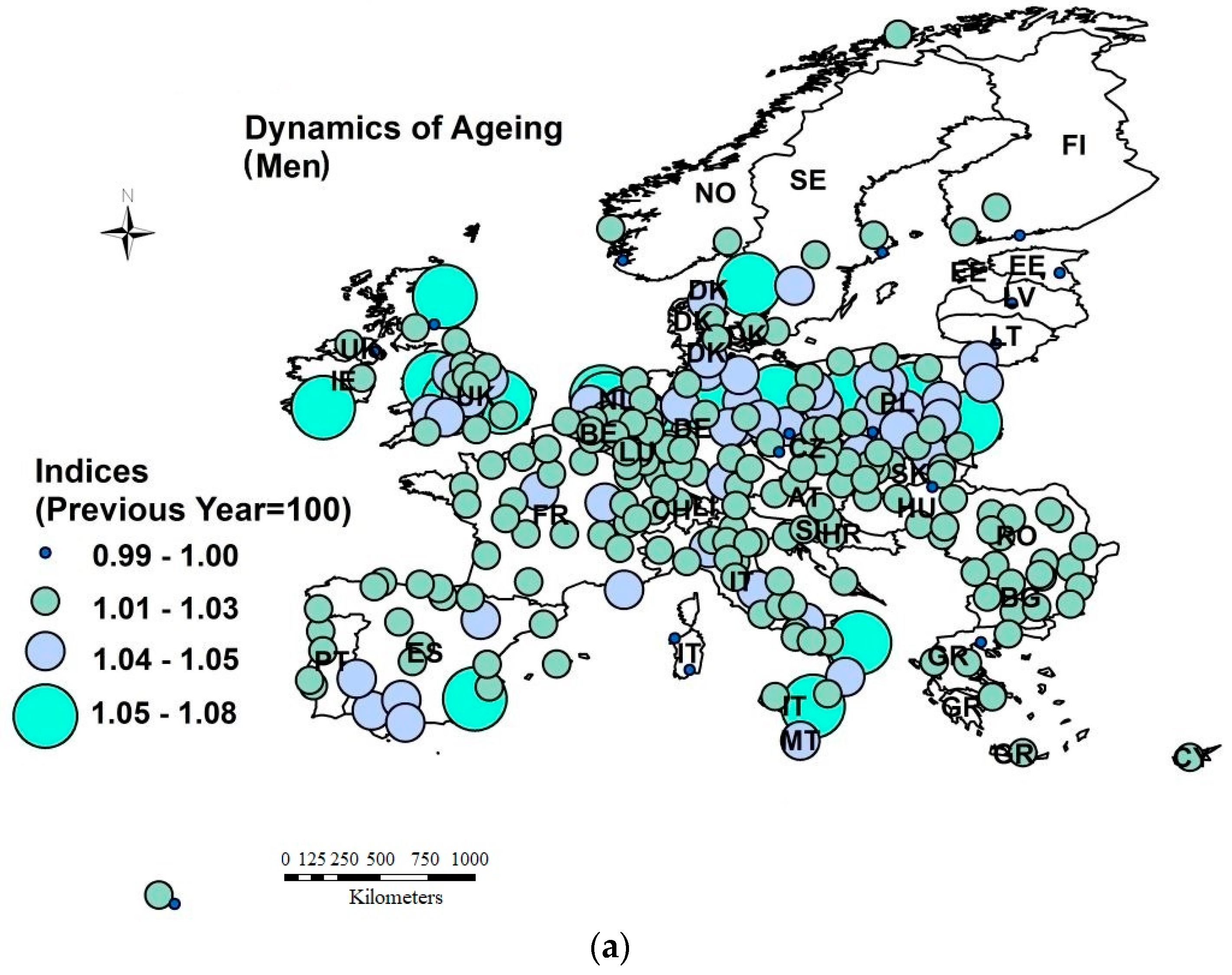


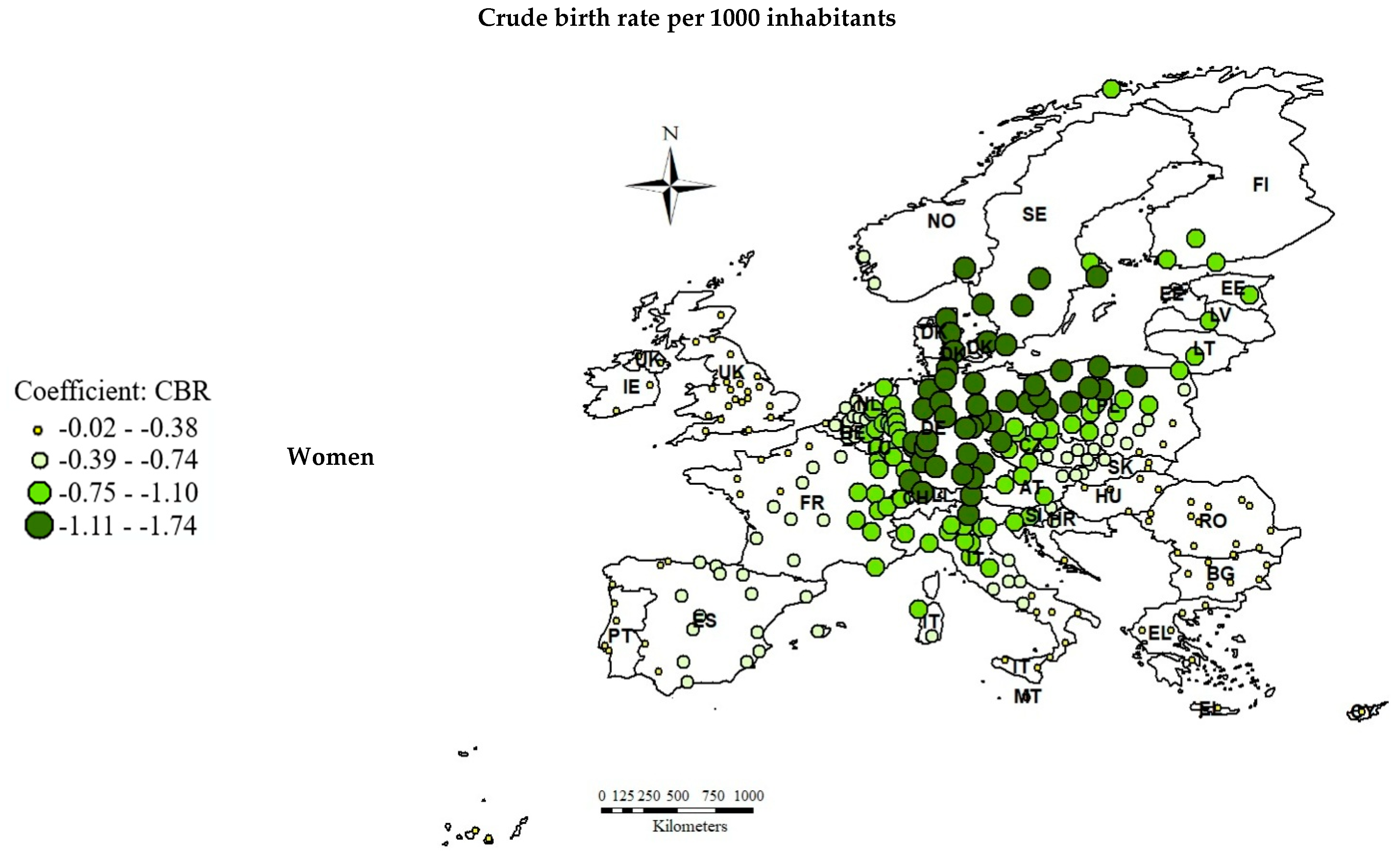
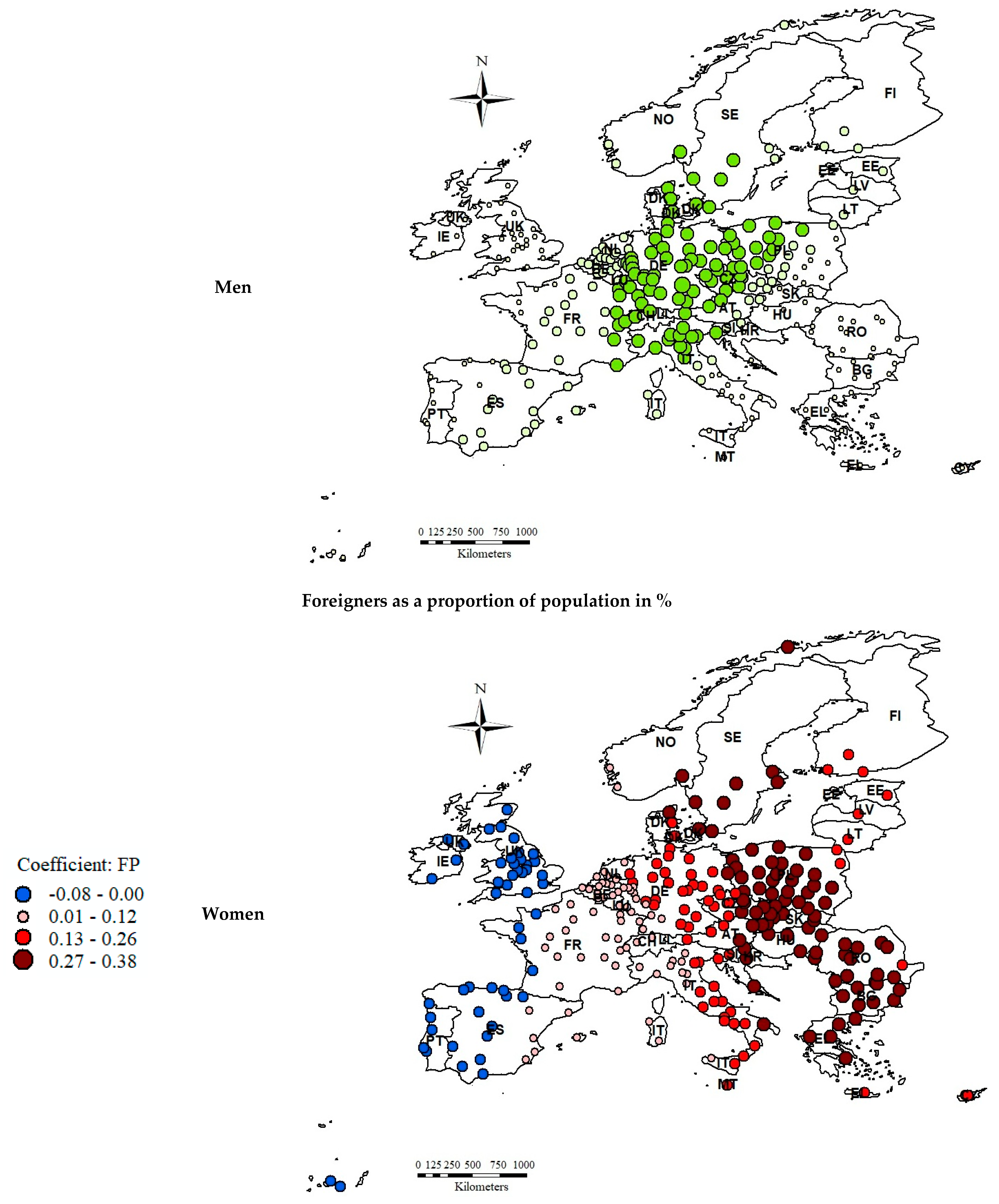
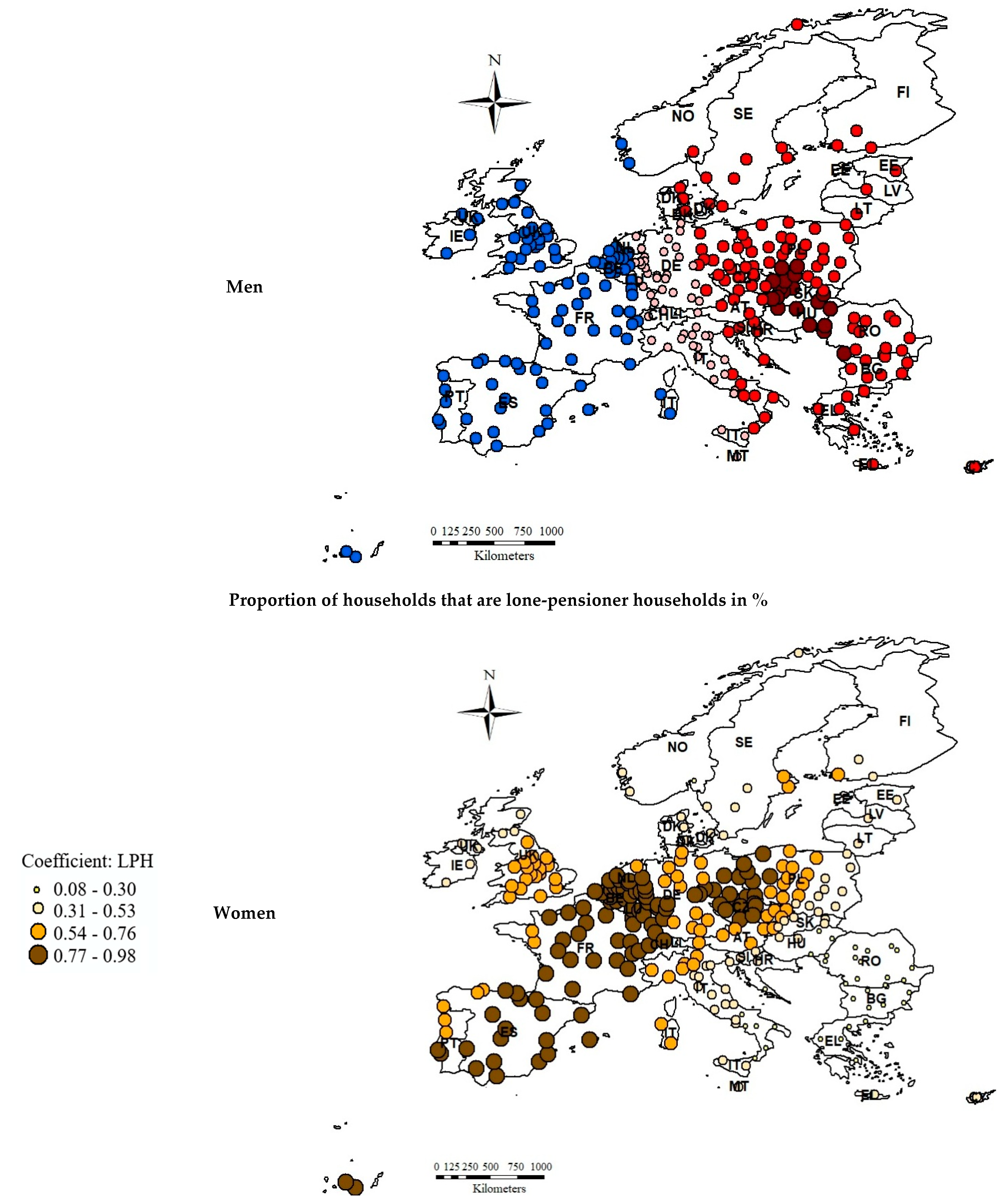
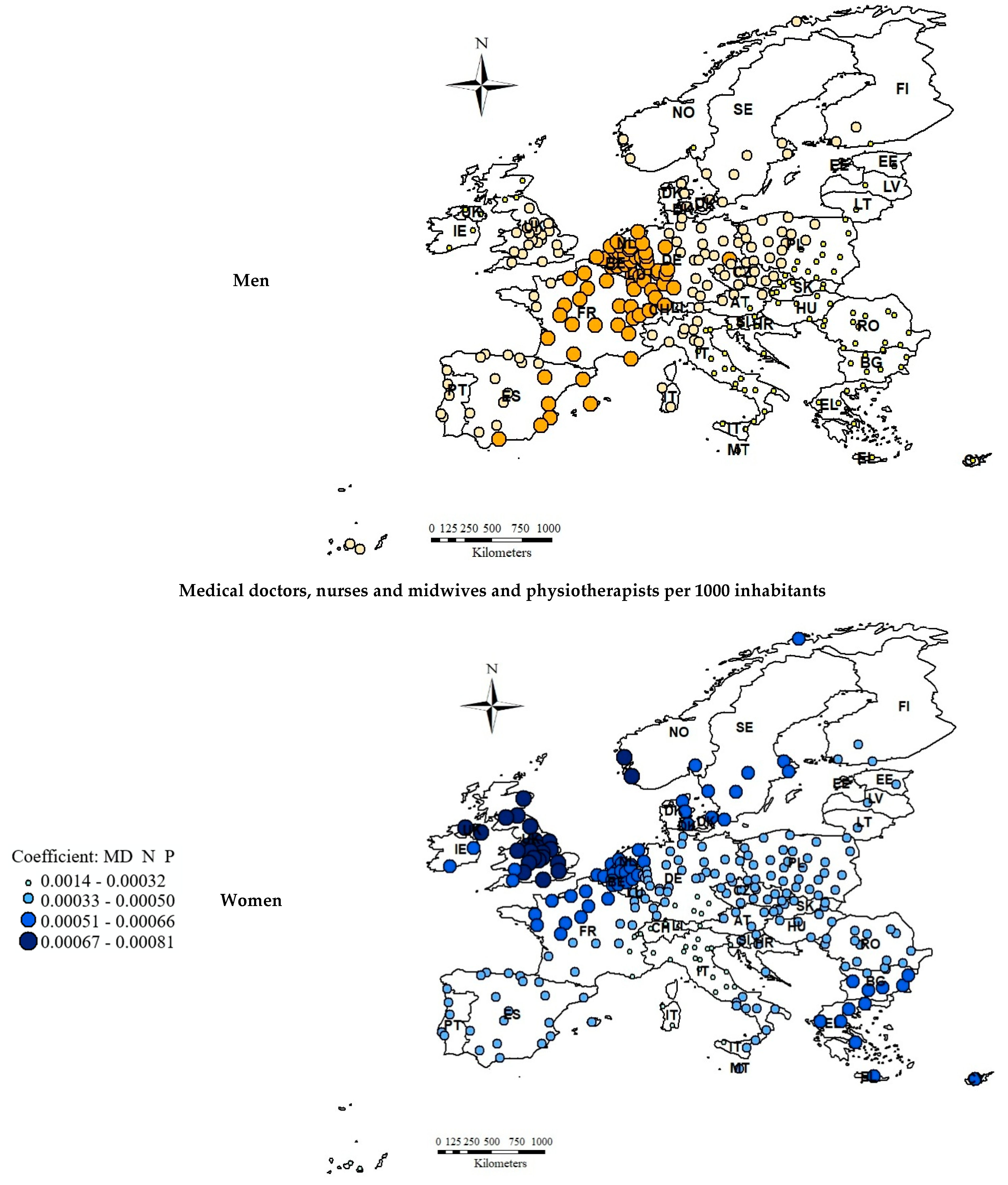
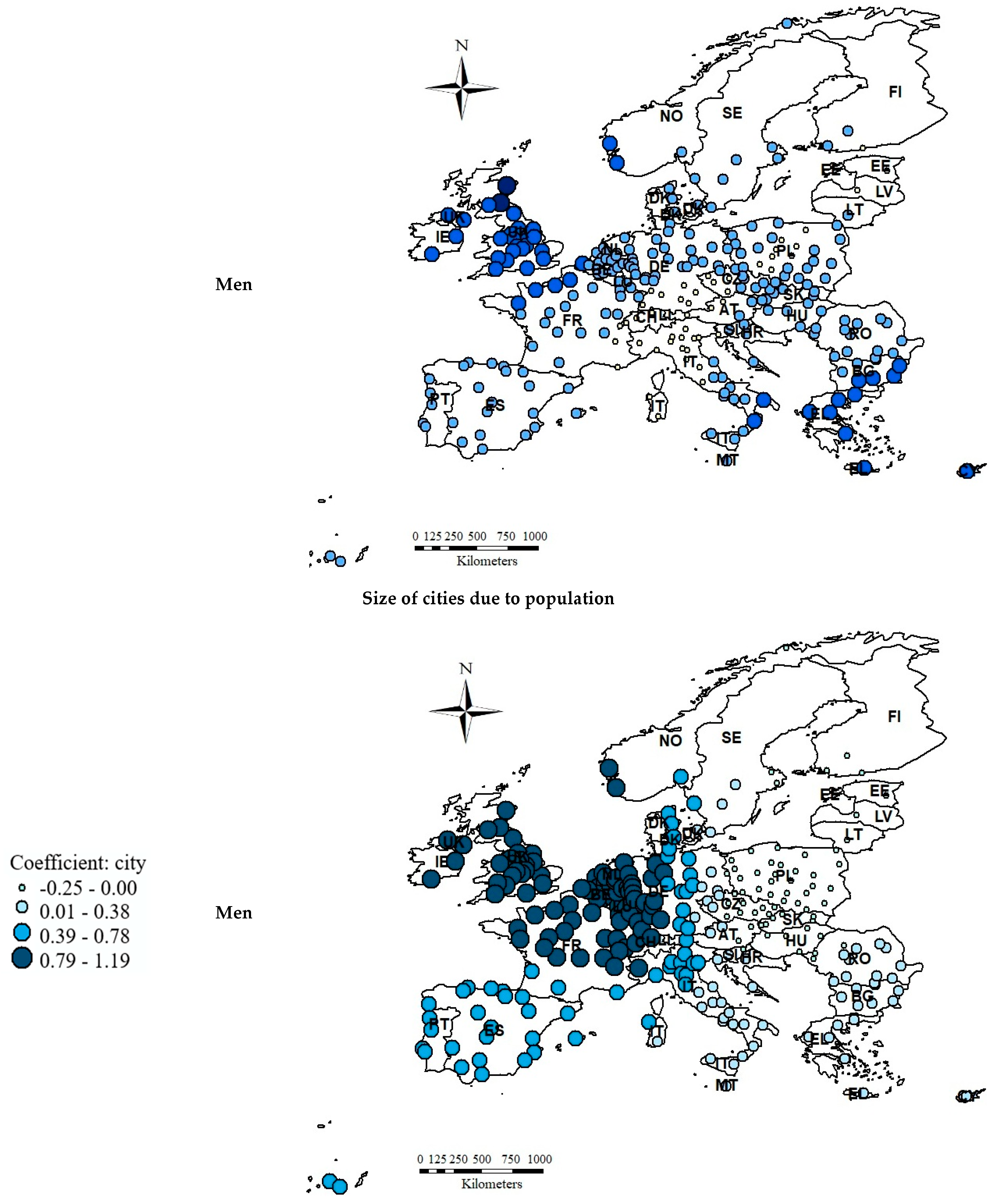
| Men | ||||||
| Mean | Median | CV | Min | Max | ANOVA Kruskal-Wallis | |
| Total | 13.1 | 12.9 | 21% | 7.7 | 20.1 | |
| <100,000 inhabitants | 14.2 | 14.2 | 14% | 10.7 | 19.0 | |
| 100,000–250,000 | 15.0 | 14.7 | 18% | 8.8 | 22.9 | |
| 250,000–500,000 | 14.4 | 13.8 | 27% | 8.2 | 23.3 | 71.21 *** |
| 500,000–1,000,000 | 11.7 | 11.1 | 20% | 7.9 | 18.3 | |
| >1,000,000 people | 12.4 | 12.8 | 12% | 9.2 | 14.5 | |
| Lower–middle income | 13.5 | 13.7 | 7% | 12.3 | 14.9 | |
| Upper–middle income | 15.2 | 15.3 | 14% | 8.8 | 19.0 | 29.63 *** |
| High income | 13.9 | 13.1 | 23% | 7.9 | 23.3 | |
| Women | ||||||
| Mean | Median | CV | Min | Max | ANOVA Kruskal-Wallis | |
| Total | 18.1 | 18.2 | 22% | 10.0 | 27.3 | |
| <100,000 inhabitants | 20.0 | 19.0 | 13% | 12.4 | 26.1 | |
| 100,000–250,000 | 19.1 | 19.0 | 17% | 13.1 | 29.5 | 1.71 |
| 250,000–500,000 | 18.5 | 18.1 | 21% | 12.7 | 29.4 | |
| 500,000–1,000,000 | 19.8 | 18.4 | 25% | 10.3 | 30.6 | |
| >1,000,000 people | 20.0 | 20.3 | 10% | 12.5 | 31.5 | |
| Lower–middle income | 19.0 | 19.2 | 6% | 16.7 | 20.1 | |
| Upper–middle income | 20.1 | 18.9 | 13% | 12.4 | 26.1 | 2.15 |
| High income | 19.1 | 19.5 | 22% | 10.3 | 31.5 | |
| Men versus women | ||||||
| Mean | Median | CV | Min | Max | Mann–Whitney U | |
| Total | 15.0 | 15.1 | 34% | 5.5 | 23.5 | 13,250 *** |
| <100,000 inhabitants | 16.1 | 16.3 | 22% | 11.0 | 26.3 | 191 *** |
| 100,000–250,000 | 17.0 | 16.6 | 23% | 9.2 | 27.5 | 2893 *** |
| 250,000–500,000 | 16.9 | 16.8 | 17% | 12.0 | 24.3 | 591 *** |
| 500,000–1,000,000 | 17.0 | 15.8 | 21% | 10.6 | 26.0 | 212 *** |
| >1,000,000 people | 16.9 | 17.3 | 17% | 12.5 | 21.2 | 58 *** |
| Lower–middle income | 16.1 | 15.5 | 16% | 13.1 | 20.4 | 17 *** |
| Upper–middle income | 16.7 | 17.0 | 18% | 10.5 | 24.0 | 411 *** |
| High income | 17.0 | 16.5 | 22% | 9.2 | 27.5 | 8383 *** |
| Variable | Description | Time Span | Group |
|---|---|---|---|
| IM | Infant mortality per year | 1991–2018 | Demography |
| CDR | Crude death rate per 1000 inhabitants | 1991–2018 | Demography |
| CBR | Crude birth rate per 1000 inhabitants | 1991–2018 | Demography |
| IMR | Infant mortality rate per 1000 live births | 1991–2018 | Demography |
| AEOL | Average area of living accommodation in m2/person | 1992–2018 | Living conditions |
| MI | Median disposable annual household income in EUR per capita | 1991–2019 | Living conditions |
| DHI | Average disposable annual household income in EUR per capita | 1998–2019 | Living conditions |
| VLWI | Share of persons living in households with very low work intensity in % | 2008–2018 | Living conditions |
| ROPST | Share of persons at risk of poverty after social transfers in % | 2008–2018 | Living conditions |
| LPH | Proportion of households that are lone-pensioner households in % | 1991–2018 | Living conditions |
| SHE | Share of students in higher education in the total population (per 1000 persons) | 1990–2018 | Education |
| WAP3_4 | Proportion of working age population qualified at level 3 or 4 ISCED in % | 1996–2018 | Education |
| EDU25_64 | Proportion of population aged 25–64 qualified at level 5 to 8 ISCED, from 2014 onwards in % | 1996–2018 | Education |
| city | Size of cities due to population: 2—below 100,000, 3—between 100,000–250,000, 4—between 250,000–500,000, 5—between 500,000–1,000,000, 6—above 1,000,000; | 1990–2018 | City size |
| PL | Number of public libraries (all distribution points) | 1990–2018 | Culture and tourism |
| CS | Number of cinema seats per 1000 residents | 1990–2018 | Culture and tourism |
| AB | Number of available beds per 1000 residents | 1990–2018 | Culture and tourism |
| TNS | Total nights spent in tourist accommodation establishments per resident population | 1990–2018 | Culture and tourism |
| UR | Unemployment rate | 1991–2018 | Labour market |
| AR | Activity rate | 1996–2018 | Labour market |
| PAF | Proportion of employment in agriculture fishery in % | 1991–2018 | Labour market |
| PEI | Proportion of employment in industries in % | 1991–2018 | Labour market |
| NP | Nationals as a proportion of population in % | 1991–2018 | Migration |
| FP | Foreigners as a proportion of population in % | 2000–2018 | Migration |
| BIC | Length of bicycle network (dedicated cycle paths and lanes in km) | 2001–2018 | Transport |
| RC | Number of registered cars per 1000 population | 1991–2019 | Transport |
| PCRA | People killed in road accidents per 10,000 pop. | 1996–2019 | Transport |
| SUN | Total number of hours of sunshine per day | 1990–2018 | Environment |
| PM10_EXC | Number of days particulate matter PM10 concentrations exceed 50 µg/m3 | 1996–2013 | Environment |
| AACPM10 | Annual average concentration of PM10 (µg/m3) | 1996–2013 | Environment |
| CPW | Share of population connected to potable drinking water system in % | 2008–2016 | Environment |
| STS | Share of population connected to sewerage treatment system in % | 2004–2016 | Environment |
| GUASL | Share of land (in %): green urban areas and sports and leisure facilities | 2012–2014 | Environment |
| NA | Share of land (in %): natural areas | 2012–2014 | Environment |
| MD_N_P | Medical doctors, nurses, midwives and physiotherapists per 1000 inhabitants | 1993–2018 | Health |
| Diagnostics | Women | Men | ||
|---|---|---|---|---|
| Global Regression (OLS) | GWR | Global Regression (OLS) | GWR | |
| R-Squared | 0.41 | 0.66 | 0.37 | 0.65 |
| Adjusted R-Squared | 0.40 | 0.62 | 0.36 | 0.61 |
| AICc | 1461.56 | 1351.97 | 1325.30 | 1199.77 |
| Moran’s I | 0.085 (0.00) * | 0.008 (0.67) | 0.114 (0.00) * | 0.005 (0.48) |
| Joint Wald Statistics | 247.76 (0.00) * | 169.82 (0.00) * | ||
| Koenker (BP) Statistic | 21.80 (0.00) * | 15.62 (0.00) * | ||
| Jarque-Bera Statistics | 3.65 (0.17) | 0.52 (0.77) | ||
| Variable | Women | Men | ||||
|---|---|---|---|---|---|---|
| Coefficient | t-Statistic | VIF | Coefficient | t-Statistic | VIF | |
| Intercept | 11.26 | 8.29 | 7.31 | 6.12 | ||
| CBR | −0.40 | −4.72 | 1.13 | −0.24 | −3.63 | 1.13 |
| FP | 0.14 | 4.12 | 1.24 | 0.08 | 3.10 | 1.32 |
| LPH | 0.46 | 5.68 | 1.18 | 0.24 | 3.70 | 1.22 |
| MD_N_P | 0.00059 | 7.60 | 1.06 | 0.00054 | 8.18 | 1.28 |
| city | - | - | 0.40 | 2.44 | 1.34 | |
© 2020 by the authors. Licensee MDPI, Basel, Switzerland. This article is an open access article distributed under the terms and conditions of the Creative Commons Attribution (CC BY) license (http://creativecommons.org/licenses/by/4.0/).
Share and Cite
Lewandowska-Gwarda, K.; Antczak, E. Urban Ageing in Europe—Spatiotemporal Analysis of Determinants. ISPRS Int. J. Geo-Inf. 2020, 9, 413. https://doi.org/10.3390/ijgi9070413
Lewandowska-Gwarda K, Antczak E. Urban Ageing in Europe—Spatiotemporal Analysis of Determinants. ISPRS International Journal of Geo-Information. 2020; 9(7):413. https://doi.org/10.3390/ijgi9070413
Chicago/Turabian StyleLewandowska-Gwarda, Karolina, and Elżbieta Antczak. 2020. "Urban Ageing in Europe—Spatiotemporal Analysis of Determinants" ISPRS International Journal of Geo-Information 9, no. 7: 413. https://doi.org/10.3390/ijgi9070413





